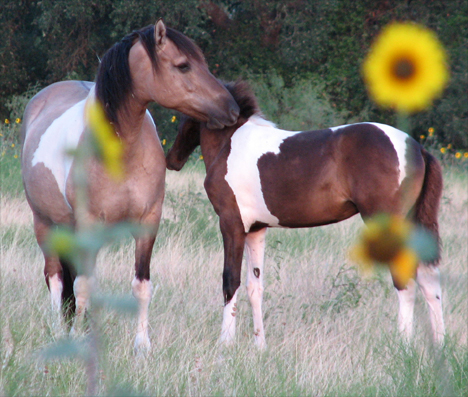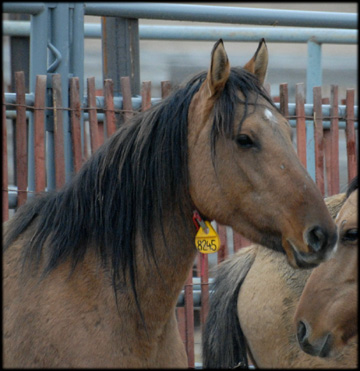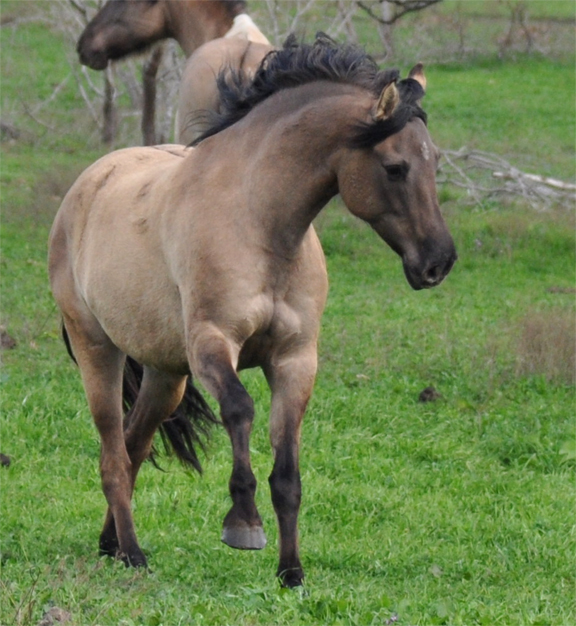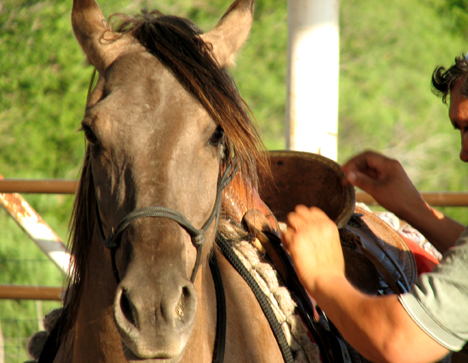Email: kigers@ranchobayo.com
rancho bayo © 2012 located in central texas usa 512.868.7638
Double click here to edit this text.
Here at Rancho Bayo, we put just as much emphasis on our mares as we do our stallions, maybe more so. The mare has the most influence over the foal as far as how their character develops and most importantly, how they view the human. While a stallion can surely genetically influence the foals temperament, the mares example plays a big part of how that molds that into either a positive or negative character.
Our Wild Mares
When choosing our wild mares, it can be hard to tell what you really have until you get them home and accustomed to humans and domestic life. I first look at conformation and movement, which can be very difficult. If I am buying a horse from a private party, there are a lot of temperament issues that can be hidden. If the mare is in a situation where she does not trust, then she can act overly flighty and scared. If the mare is not handled much, then they can seem overly docile as she is not asked to participate with the human regularly.
Our Wild Mares
When choosing our wild mares, it can be hard to tell what you really have until you get them home and accustomed to humans and domestic life. I first look at conformation and movement, which can be very difficult. If I am buying a horse from a private party, there are a lot of temperament issues that can be hidden. If the mare is in a situation where she does not trust, then she can act overly flighty and scared. If the mare is not handled much, then they can seem overly docile as she is not asked to participate with the human regularly.



When they are brought in from the wild and viewing them in the pens, it is again very hard to discern their true character. They have been through alot of trauma and this will influence them either into super survival mode or make them seemingly reserved as they are very fearful. It is also hard to make much out of movement as they really don't move too much and when they do, movement is stilted and tight. Knowing conformation and how it applies to movement is very important at this stage of evaluation.
I also want to see a mare somewhere in the middle of the herd. I will not pick a mare if she is too aggressive and everyone parts like the red sea when she walks around. I also look for a mare that can be moved easily by another mare without being too flighty or stand her ground and even kick in the direction of the pushing mare. I look for mares that quietly mind their own business but are not afraid of the others.
It is important to me that the mares develop a high level of trust with me, not only so they can be handled safely, but so they show their foals proper attitudes towards humans. I work hard at getting their trust, never trying to betray that; yet on the other hand, showing them good leadership and firm boundries as to what is acceptable and what is not.
I also want to see a mare somewhere in the middle of the herd. I will not pick a mare if she is too aggressive and everyone parts like the red sea when she walks around. I also look for a mare that can be moved easily by another mare without being too flighty or stand her ground and even kick in the direction of the pushing mare. I look for mares that quietly mind their own business but are not afraid of the others.
It is important to me that the mares develop a high level of trust with me, not only so they can be handled safely, but so they show their foals proper attitudes towards humans. I work hard at getting their trust, never trying to betray that; yet on the other hand, showing them good leadership and firm boundries as to what is acceptable and what is not.

Our Domestic Mares
Part of our breeding program each year, is to develop mares from our own herd. Many foals are bred specifically with the intent of being future broodmares at Rancho Bayo. I focus on forming a special bond with these fillies from day one and work hard to cultivate that over the years. I want them to be very attached to me, with a high level of trust and respect. Foals learn from the example of their mother from day one. If a mare is leery of humans, the foal immediately picks up on it and that part of their character can be ingrained in them forever. Each foal, however, is an individual and I have had instances where the mare is cautious, yet the foal seems drawn to people from day one. On the other hand, some foals need more interaction to help them develop trust no matter how docile the mare is.
Even in the fillies I have earmarked for the breeding program, I expect them to prove themselves in a lot of areas as they develop. Not only must they be able to develop the deep bond with me, but they need to be highly trainable and naturally maternal. We can see early on those fillies that have the motherly instinct and those who could care less. This is really seen first when the mares have new foals and are turned out with the yearling fillies. Some take a deep interest in the new life, others steer clear. We see this again when the foals are weaned and now the yearling "aunties" must tend to them. Some older fillies are enthralled with the younger ones and even make it their business to keep them away from the others who many not be so accepting, protecting and watching over them. This is paramount in whether or not they remain breeding material.
Part of our breeding program each year, is to develop mares from our own herd. Many foals are bred specifically with the intent of being future broodmares at Rancho Bayo. I focus on forming a special bond with these fillies from day one and work hard to cultivate that over the years. I want them to be very attached to me, with a high level of trust and respect. Foals learn from the example of their mother from day one. If a mare is leery of humans, the foal immediately picks up on it and that part of their character can be ingrained in them forever. Each foal, however, is an individual and I have had instances where the mare is cautious, yet the foal seems drawn to people from day one. On the other hand, some foals need more interaction to help them develop trust no matter how docile the mare is.
Even in the fillies I have earmarked for the breeding program, I expect them to prove themselves in a lot of areas as they develop. Not only must they be able to develop the deep bond with me, but they need to be highly trainable and naturally maternal. We can see early on those fillies that have the motherly instinct and those who could care less. This is really seen first when the mares have new foals and are turned out with the yearling fillies. Some take a deep interest in the new life, others steer clear. We see this again when the foals are weaned and now the yearling "aunties" must tend to them. Some older fillies are enthralled with the younger ones and even make it their business to keep them away from the others who many not be so accepting, protecting and watching over them. This is paramount in whether or not they remain breeding material.

Expectations and Training
As the fillies turn three years old, they are brought up out of the Wild Bunch and begin training. They get re-accustomed to being stalled, which we vary from week to week. Sometimes they are kept out in small groups in pasture, sometimes they are stalled at night and out during the day, sometimes they are stalled with a paddock. We switch horses around, both in the pasture and stalled next to each other so the fillies learn about change and how to adapt quicker.
If they have not already, they learn to stand in the vet stocks and eventually tied. Their training program consists of round pen work, on-line work and the obstacle course. They are saddled and most get at least 30 days of riding. This further tells us of their trainability and character. A mare that does not excel in the training pen is no longer considered breeding material and her under saddle work will be further developed as she is put up for sale. While these mares make great saddle horses, we look for specific abilities and attitudes for the future of our program and we only pick the best of the best.
As the fillies turn three years old, they are brought up out of the Wild Bunch and begin training. They get re-accustomed to being stalled, which we vary from week to week. Sometimes they are kept out in small groups in pasture, sometimes they are stalled at night and out during the day, sometimes they are stalled with a paddock. We switch horses around, both in the pasture and stalled next to each other so the fillies learn about change and how to adapt quicker.
If they have not already, they learn to stand in the vet stocks and eventually tied. Their training program consists of round pen work, on-line work and the obstacle course. They are saddled and most get at least 30 days of riding. This further tells us of their trainability and character. A mare that does not excel in the training pen is no longer considered breeding material and her under saddle work will be further developed as she is put up for sale. While these mares make great saddle horses, we look for specific abilities and attitudes for the future of our program and we only pick the best of the best.

When the fillies turn two, they are turned out back on a large 100 acre, primitive pasture with what is known as the "Wild Bunch". This consists of all mares, a few of which are very wild mares and some senior broodmares, so they can learn the ropes of being a horse. The varied terrain, one water source and large herd environment helps them further develop their true character. I begin to notice how they fit into the herd, how they learn to forage and take example from the more experienced mares plus how they treat their own position in the herd. If a filly goes out there and becomes defensive or even begins to show unstable behavior such as aggression in the herd, she is no longer a broodmare candidate.
A very big focus of ours is to develop good liberty work and obstacle work with our future broodmares. Both of these venues will be utilized when they have foals at their sides so they can set a prime example for the foal as to how they should act and accept leadership.
Once a mare foals, her behavior is monitored and evaluated. She must be an attentive momma, deeply caring for her foal. She must be a good protector, thus developing security in her foal which can affect the foals behavior later in life. The mare must be a good teacher; guiding her foal through life in a relaxed yet firm manner. Fillies will learn from example how to be a good momma later in life - our best mares produce our best future broodmares. Colts must be reprimanded when necessary and shown boundaries early on. Passive mares usually produce very obnoxious colts which can turn into very obnoxious stallions later on!
We do give special consideration for maiden mares, letting them learn from the example of the other mares in the herd after all the foals are born. However, we do not stand for any aggressive attitudes, either toward foals or other mares. A mare that is not attentive to her foal or has no natural maternal instinct is not re-bred.
We expect the best from our broodmares, as they need to be shining examples for the next generation...
Once a mare foals, her behavior is monitored and evaluated. She must be an attentive momma, deeply caring for her foal. She must be a good protector, thus developing security in her foal which can affect the foals behavior later in life. The mare must be a good teacher; guiding her foal through life in a relaxed yet firm manner. Fillies will learn from example how to be a good momma later in life - our best mares produce our best future broodmares. Colts must be reprimanded when necessary and shown boundaries early on. Passive mares usually produce very obnoxious colts which can turn into very obnoxious stallions later on!
We do give special consideration for maiden mares, letting them learn from the example of the other mares in the herd after all the foals are born. However, we do not stand for any aggressive attitudes, either toward foals or other mares. A mare that is not attentive to her foal or has no natural maternal instinct is not re-bred.
We expect the best from our broodmares, as they need to be shining examples for the next generation...